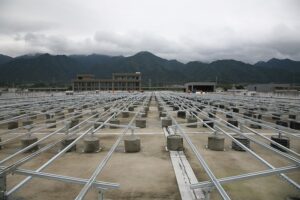
The Art of Clean Energy: Integrating Nature into Urban Development
As cities around the globe grapple with the consequences of rapid urbanization and growing populations, the challenge of sustainable development has never been more pressing. The integration of clean energy solutions with principles drawn from nature offers a transformative approach to urban development. This article explores the multifaceted relationship between nature and sustainable urban living, examining innovative strategies that combine ecological sensitivity with modern urban infrastructure.
The Need for Sustainable Urban Development
Urban areas are now home to more than half the world’s population, and this figure is projected to increase. This rapid urbanization leads to significant environmental, social, and economic challenges, including air and water pollution, loss of biodiversity, and increased carbon emissions. As cities expand, finding ways to incorporate clean energy and sustainable practices has become imperative for their survival and resilience.
The traditional model of urban development—characterized by concrete buildings, a lack of greenery, and heavy reliance on fossil fuels—is increasingly being rejected in favor of greener alternatives. The art of clean energy signifies a profound shift towards creating cities that respect and integrate with the natural environment, thereby enhancing the quality of life for urban dwellers.
Nature-Based Solutions in Urban Settings
Nature-based solutions (NbS) lend themselves perfectly to coupling urban development with clean energy initiatives. These solutions leverage natural processes and ecosystems to address urban challenges. By employing these methods, cities can improve biodiversity, enhance air and water quality, and bolster the resilience of urban areas.
One prominent example of NbS is the creation of green roofs and walls. These features not only provide insulation but also support urban wildlife, capture rainwater, and improve air quality through plant photosynthesis. Cities like Singapore have taken bold strides in pursuing vertical gardening, turning buildings into living structures that contribute positively to the urban ecosystem.
Urban Forestry and the Carbon Sink
Urban forests are another essential element of integrating nature into city architecture. By increasing canopy cover, cities can effectively combat the urban heat island effect, reduce energy consumption for cooling, and serve as crucial carbon sinks. Urban trees absorb carbon dioxide and enhance local biodiversity by providing habitat to various species.
Incorporating forestry into urban planning can be creatively executed through tree-lined streets and parks, developing community gardens, and restoring degraded lands. Furthermore, engaging local communities in tree-planting initiatives fosters social cohesion and environmental stewardship among residents.
Renewable Energy Sources: Solar and Wind Integration
Integrating clean energy sources—such as solar and wind—into urban design is vital for reducing dependence on non-renewable power. Solar panels can be seamlessly incorporated into building designs, from rooftops to facades, allowing metropolitan areas to harness solar energy effectively. This technology not only contributes to renewable energy production but also enhances building aesthetics when applied creatively.
Wind energy can also play a role in urban energy production. Innovative designs for urban wind turbines are emerging, allowing cities to capitalize on wind currents even in dense environments. By strategically placing these turbines in parks and along coastlines, cities can further diversify their clean energy portfolios.
Water Management and Urban Design
A vital yet often overlooked facet of integrating nature into urban settings is the management of water resources. Urban areas face the dual challenges of flooding and water scarcity, necessitating sustainable water management strategies. By mimicking natural hydrological processes through permeable pavements, rain gardens, and green infrastructure, cities can effectively manage stormwater runoff and replenish groundwater supplies.
Green infrastructure not only helps mitigate flooding but also improves the aesthetic and functional characteristics of urban spaces. Innovative uses of detention ponds or constructed wetlands provide recreational areas and ecological habitats, demonstrating how clean energy and environmental management can enhance urban life.
Smart Cities and Technological Integration
The rise of smart technology offers exciting opportunities for enhancing urban sustainability. Smart grids, energy-efficient buildings, and intelligent transportation systems can all contribute to a cleaner urban environment. By collecting data on energy use and environmental conditions, cities can optimize resource management and reduce waste.
Furthermore, integrating nature with technology can yield dual benefits. For instance, smart irrigation systems for green spaces can conserve water while ensuring that urban greenery thrives. By using sensors and data analytics, cities can fine-tune their ecosystem management to enhance biodiversity and urban resilience.
Community Engagement in Sustainability Practices
Successful integration of nature into urban development hinges upon community engagement and support. Involving residents in the planning process fosters a sense of ownership and responsibility for local environments. Community initiatives—such as local food gardens, tree planting campaigns, and awareness programs—can promote an understanding of the importance of sustainability and encourage greener lifestyles.
Educational programs in schools can instill the values of environmental stewardship from a young age, nurturing future generations of engaged citizens ready to advocate for sustainable practices and clean energy solutions.
Policy Frameworks and Regulatory Support
To foster the development of sustainable cities, it is paramount to have supportive policy frameworks that encourage the integration of clean energy and nature. Governments can play a crucial role by providing incentives for green building designs, investing in renewable energy infrastructure, and facilitating public transportation systems that support eco-friendliness.
Incentives such as tax breaks for renewable energy investments, grants for urban green spaces, and regulations that require the inclusion of NbS in development proposals can catalyze the transition toward sustainable cities. Legislation aimed at reducing emissions and preserving natural habitats will pave the way for healthier urban ecosystems.
Conclusion: The Future of Clean Energy and Urban Living
The art of clean energy, when harmoniously integrated with nature, presents a forward-thinking model for urban development. By blending ecological sensitivity with innovative urban planning, cities can not only meet the needs of their growing populations but also safeguard the environment for future generations.
As urban centers evolve, fostering a symbiotic relationship between humanity and nature will be vital to cultivating sustainable and vibrant urban landscapes. The journey toward integrating nature into urban development is an ongoing and collaborative effort that requires creativity, commitment, and a shared vision of a greener, more resilient future.
In embracing this approach, cities can redefine their identities and cultivate an environment that thrives on clean energy, biodiversity, and community well-being. The art of clean energy will undeniably shape the urban landscapes of tomorrow, creating spaces that harmonize with nature while fulfilling the aspirations of the communities they serve.



